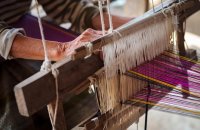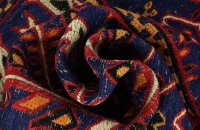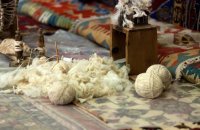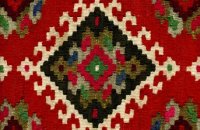



Compared to ultra modern fabrics with their invisible weave, the traditional loom with its clean, distinct strands looks ancient. And indeed it is!
The history of the loom starts as early as the mid- seventh millennium. The patroness of weaving in ancient times seems to have been the Goddess Athena, so called "Athena Ergane." Also, all the Minoan and Mycenaean palaces of the second millennium had workshops with vertical looms. Possibly the first mention of weaving within the Greek literary tradition is in Homer’s Odyssey, as the faithful Penelope wove during day and during the night unraveled what she had woven, confounding her would-be suitors as they waited for her to finish the death shroud for her father-in-law.
The relationship with the loom has continued uninterrupted of course, and in subsequent years, many folk songs refer metaphorically to the relationship of the weaver and her loom.
"And all day tock tock tock, tuk tuk tuk, goes your shuttle.
Your cloth and your answer, lead me into temptation .... ! "
(‘o Argaleios’ /Kostas Mountakis / Crete)
"Fly, my swift shuttle, with fine silk
to come my love at Eastertide, to find gold to trade
Tick-tock, my loom, tick and tock and comes my love
His scarf unstained by tears in foreign lands,
noble mistresses seek him, yet he aches for me.
Tick-tock in my garden, until my bird returns. "
(‘Skopi’/ Sophia Vembo 1947)
The biggest boom in the Greek textile industry took place in the 18th and 19th century, along with the general revival of Hellenism. In modern times the loom was the most necessary and valuable tool for every household. On Crete, the loom was called the ‘Argastiri’, i.e. laboratory. The loom provided for all the needs of the family, from simple clothing and bedding up to and including the dowry that the village girls would weave in anticipation of their marriage.
The works were distinguished for their color combinations and the richness of their decorative themes. The raw materials for weaving were mainly sheep’s wool, cotton, linen, and silk; products that they found ready to hand as ranchers and farmers. After spinning, the thread would be dyed with colors derived from roots, leaves or fruit. From the Dyer’s Madder bush (Rubia tinctorum) comes the famous red. Husks of fresh walnuts give black, the fruit of the white mulberry an indigo blue, a few leaves of appletree a canary yellow. Then the threads were boiled in these color solutions, throwing in a little oil, vinegar and salt to make them colorfast.
Each region, following its distinct artistic conception, created its own tradition in the weaving of kilim rugs. The rugs of each region are distinguished by their color. Their designs were connected with the history, geography, and culture of the region. The designs vary from the rather simple, with geometric patterns or religious symbols, to very ornate, with flowers and animal motifs. These patterns are often very distinctive, and specify the name of the rugs. Most rugs are woven and passed down to future generations. One of the most impressive works of embroidery are the “many shapes and Many Names,” kilims for the wall that adorn the interiors of the houses of the Aegean archipelago and Northern Greece. Equally beautiful is the "Red Pattani" of Crete with its narrow sides, one of the finest examples of Modern Greek weaving. Let us mention that in some villages, the multilayered tapestries still adorn the walls of the house of the bride on her wedding day. The finest examples of this style of weaving come from the village of Kissamos, western Crete. The ‘Geraki’ rugs are still featured in dowries. For the quality of their workmanship and their traditionally inspired designs, Geraki carpets have won international awards and accolades. Even today, they remain a key element in the traditional decorating of a house. Women today still weave traditional rugs, and display them in various permanent exhibitions or in folk art museums.
The elegant creations of this folk art, beyond their utilitarian value, have been a means of artistic expression of women, (mainly because typically women are involved with the textile arts), leaving us with a valuable cultural heritage for which we are most grateful!











